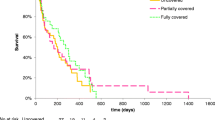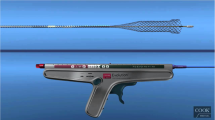Abstract
Background
The self-expandable metallic stent (SEMS) has been widely used for unresectable malignant biliary obstruction but eventually becomes occluded by tumor ingrowth/overgrowth and sludge. Therefore, we aimed to determine the therapeutic effectiveness of secondary stents and to find differences according to various combinations of the first and second stents for the management of occluded SEMSs in patients with malignant distal biliary obstruction.
Methods
Between 1999 and November 2008, 77 patients with malignant biliary obstruction underwent secondary biliary stent placement as “stent-in-stent” at three university hospitals in Korea (40 covered, 26 uncovered, and 11 plastic stents). The membrane of the covered SEMS was regarded as the barrier against tumor ingrowth. We categorized the patients into three groups based on whether the covered SEMS was either the first or the second stent: membrane-SEMS (18 covered–covered; 9 covered–uncovered; 22 uncovered–covered SEMS), bare-SEMS (17 uncovered–uncovered SEMS), and plastic stent (3 covered-plastic; 8 uncovered-plastic).
Results
The median patency of second stents was 138, 109, and 88 days (covered, uncovered, and plastic stents). The second covered SEMSs had a significantly longer patency than plastic stents (p = 0.047). In a multivariate analysis including membrane-SEMS, bare-SEMS, and plastic stent groups, the bare-SEMS had a worse cumulative stent patency (HR = 2.04, CI = 1.08–3.86) and survival time (HR = 2.37, CI = 1.25–4.49) than the membrane-SEMS. Patients with ampulla of Vater cancer had better stent patency (HR = 0.27, CI = 0.08–0.98) and survival (HR = 0.17, CI = 0.04–0.77) than those with other pancreatobiliary malignancies. In addition, antitumor treatment prolonged survival time (HR = 0.50, CI = 0.26–0.99).
Conclusions
The placement of additional biliary stents using the “stent-in-stent” method is an effective treatment for an occluded metallic primary stent. In addition, double biliary SEMS placement using at least one covered SEMS (in the primary and/or secondary procedure) might provide longer cumulative stent patency and survival than using uncovered SEMSs in both procedures.




Similar content being viewed by others
References
Isayama H, Komatsu Y, Tsujino T, Sasahira N, Hirano K, Toda N, Nakai Y, Yamamoto N, Tada M, Yoshida H, Shiratori Y, Kawabe T, Omata M (2004) A prospective randomised study of “covered” versus “uncovered” diamond stents for the management of distal malignant biliary obstruction. Gut 53:729–734
Togawa O, Kawabe T, Isayama H, Nakai Y, Sasaki T, Arizumi T, Matsubara S, Ito Y, Yamamoto N, Sasahira N, Hirano K, Tsujino T, Toda N, Tada M, Yoshida H, Omata M (2008) Management of occluded uncovered metallic stents in patients with malignant distal biliary obstructions using covered metallic stents. J Clin Gastroenterol 42:546–549
Castano R, Lopes TL, Alvarez O, Calvo V, Luz LP, Artifon EL (2010) Nitinol biliary stent versus surgery for palliation of distal malignant biliary obstruction. Surg Endosc. doi:10.1007/s00464-010-0903-7
Schima W, Prokesch R, Osterreicher C, Thurnher S, Fugger R, Schofl R, Havelec L, Lammer J (1997) Biliary Wallstent endoprosthesis in malignant hilar obstruction: long-term results with regard to the type of obstruction. Clin Radiol 52:213–219
O’Brien S, Hatfield AR, Craig PI, Williams SP (1995) A three year follow-up of self expanding metal stents in the endoscopic palliation of longterm survivors with malignant biliary obstruction. Gut 36:618–621
Davids PH, Groen AK, Rauws EA, Tytgat GN, Huibregtse K (1992) Randomised trial of self-expanding metal stents versus polyethylene stents for distal malignant biliary obstruction. Lancet 340:1488–1492
Polydorou AA, Cairns SR, Dowsett JF, Hatfield AR, Salmon PR, Cotton PB, Russell RC (1991) Palliation of proximal malignant biliary obstruction by endoscopic endoprosthesis insertion. Gut 32:685–689
Shepherd HA, Royle G, Ross AP, Diba A, Arthur M, Colin-Jones D (1988) Endoscopic biliary endoprosthesis in the palliation of malignant obstruction of the distal common bile duct: a randomized trial. Br J Surg 75:1166–1168
Kaassis M, Boyer J, Dumas R, Ponchon T, Coumaros D, Delcenserie R, Canard JM, Fritsch J, Rey JF, Burtin P (2003) Plastic or metal stents for malignant stricture of the common bile duct? Results of a randomized prospective study. Gastrointest Endosc 57:178–182
Prat F, Chapat O, Ducot B, Ponchon T, Pelletier G, Fritsch J, Choury AD, Buffet C (1998) A randomized trial of endoscopic drainage methods for inoperable malignant strictures of the common bile duct. Gastrointest Endosc 47:1–7
Arguedas MR, Heudebert GH, Stinnett AA, Wilcox CM (2002) Biliary stents in malignant obstructive jaundice due to pancreatic carcinoma: a cost-effectiveness analysis. Am J Gastroenterol 97:898–904
Yoon WJ, Ryu JK, Yang KY, Paik WH, Lee JK, Woo SM, Park JK, Kim YT, Yoon YB (2009) A comparison of metal and plastic stents for the relief of jaundice in unresectable malignant biliary obstruction in Korea: an emphasis on cost-effectiveness in a country with a low ERCP cost. Gastrointest Endosc 70:284–289
Moss AC, Morris E, Leyden J, MacMathuna P (2007) Malignant distal biliary obstruction: a systematic review and meta-analysis of endoscopic and surgical bypass results. Cancer Treat Rev 33:213–221
Ridtitid W, Rerknimitr R, Janchai A, Kongkam P, Treeprasertsuk S, Kullavanijaya P (2010) Outcome of second interventions for occluded metallic stents in patients with malignant biliary obstruction. Surg Endosc. doi:10.1007/s00464-010-0931-3
Park do H, Kim MH, Choi JS, Lee SS, Seo DW, Kim JH, Han J, Kim JC, Choi EK, Lee SK (2006) Covered versus uncovered wallstent for malignant extrahepatic biliary obstruction: a cohort comparative analysis. Clin Gastroenterol Hepatol 4:790–796
Yang KY, Ryu JK, Seo JK, Woo SM, Park JK, Kim YT, Yoon YB (2009) A comparison of the Niti-D biliary uncovered stent and the uncovered Wallstent in malignant biliary obstruction. Gastrointest Endosc 70:45–51
Yoon WJ, Lee JK, Lee KH, Lee WJ, Ryu JK, Kim YT, Yoon YB (2006) A comparison of covered and uncovered Wallstents for the management of distal malignant biliary obstruction. Gastrointest Endosc 63:996–1000
Bueno JT, Gerdes H, Kurtz RC (2003) Endoscopic management of occluded biliary Wallstents: a cancer center experience. Gastrointest Endosc 58:879–884
Rogart JN, Boghos A, Rossi F, Al-Hashem H, Siddiqui UD, Jamidar P, Aslanian H (2008) Analysis of endoscopic management of occluded metal biliary stents at a single tertiary care center. Gastrointest Endosc 68:676–682
Tham TC, Carr-Locke DL, Vandervoort J, Wong RC, Lichtenstein DR, Van Dam J, Ruymann F, Chow S, Bosco JJ, Qaseem T, Howell D, Pleskow D, Vannerman W, Libby ED (1998) Management of occluded biliary Wallstents. Gut 42:703–707
Soderlund C, Linder S (2006) Covered metal versus plastic stents for malignant common bile duct stenosis: a prospective, randomized, controlled trial. Gastrointest Endosc 63:986–995
Disclosures
Drs. J. H. Cho, T. J. Jeon, J. Y. Park, H. M. Kim, Y. J. Kim, S. W. Park, J. B. Chung, S. Y. Song, and S. Bang have no conflicts of interest or financial ties to disclose.
Author information
Authors and Affiliations
Corresponding author
Rights and permissions
About this article
Cite this article
Cho, J.H., Jeon, T.J., Park, J.Y. et al. Comparison of outcomes among secondary covered metallic, uncovered metallic, and plastic biliary stents in treating occluded primary metallic stents in malignant distal biliary obstruction. Surg Endosc 25, 475–482 (2011). https://doi.org/10.1007/s00464-010-1196-6
Received:
Accepted:
Published:
Issue Date:
DOI: https://doi.org/10.1007/s00464-010-1196-6




